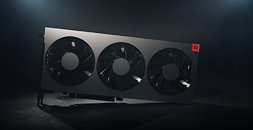Thursday, January 10th 2019

NVIDIA CEO Jensen Huang on Radeon VII: "Underwhelming (...) the Performance is Lousy"; "Freesync Doesn't Work"
PC World managed to get a hold of NVIDIA CEO Jensen Huang, picking his thoughts on AMD's recently announced Radeon VII. Skirting through the usual amicable, politically correct answers, Jensen made his thoughts clear on what the competition is offering to compete with NVIDIA's RTX 2000 series. The answer? Vega VII is an "underwhelming product", because "The performance is lousy and there's nothing new. [There's] no ray tracing, no AI. It's 7nm with HBM memory that barely keeps up with a 2080. And if we turn on DLSS we'll crush it. And if we turn on ray tracing we'll crush it." Not content on dissing the competition's product, Jensen Huang also quipped regarding AMD's presentation and product strategy, saying that "It's a weird launch, maybe they thought of it this morning."Of course, the real market penetration of the technologies Jensen Huang mentions is currently extremely low - only a handful of games support NVIDIA's forward-looking ray tracing technologies. That AMD chose to not significantly invest resources and die-space for what is essentially a stop-gap high-performance card to go against NVIDIA's RTX 2080 means its 7 nm 331 mm² GPU will compete against NVIDIA's 12 nm, 545 mm² die - if performance estimates are correct, of course.The next remarks came regarding AMD's FreeSync (essentially a name for VESA's Adaptive Sync), which NVIDIA finally decided to support on its GeForce graphics cards - something the company could have done outright, instead of deciding to go the proprietary, module-added, cost-increased route of G-Sync. While most see this as a sign that NVIDIA has seen a market slowdown for its G-Sync, added price-premium monitors and that they're just ceding to market demands, Huang sees it another way, saying that "We never competed. [FreeSync] was never proven to work. As you know, we invented the area of adaptive sync. The truth is most of the FreeSync monitors do not work. They do not even work with AMD's graphics cards." In the wake of these word from Jensen, it's hard to understand the overall silence from users that might have their FreeSync monitors not working.
Reportedly, NVIDIA only found 12 out of 400 FreeSync-supporting monitors to support their G-Sync technology automatically in the initial battery of tests, with most panels requiring a manual override to enable the technology. Huang promised that "We will test every single card against every single monitor against every single game and if it doesn't work, we will say it doesn't work. And if it does, we will let it work," adding a snarky punchline to this matter with an "We believe that you have to test it to promise that it works, and unsurprisingly most of them don't work." Fun times.
Source:
PC World
Reportedly, NVIDIA only found 12 out of 400 FreeSync-supporting monitors to support their G-Sync technology automatically in the initial battery of tests, with most panels requiring a manual override to enable the technology. Huang promised that "We will test every single card against every single monitor against every single game and if it doesn't work, we will say it doesn't work. And if it does, we will let it work," adding a snarky punchline to this matter with an "We believe that you have to test it to promise that it works, and unsurprisingly most of them don't work." Fun times.



270 Comments on NVIDIA CEO Jensen Huang on Radeon VII: "Underwhelming (...) the Performance is Lousy"; "Freesync Doesn't Work"
RTX is an afterthought. This was never about realtime RT, it was about producing content more efficiently. And that is proven by the complete lack of RTRT content. RTX is a complete gamble and it was cheap for Nvidia to do, they had to offload those faulty Quadros somewhere anyway. In that sense the risk they take is low, and you can rest assured they have a non-RT alternative escape route. We already heard rumors about GTX 11xx...
Let revisit this say mid-March-April and see what plays out.AND let's not forget Nvidia, they've been complacent also... RTX 2060 is a dud for $350 being 2019.
nVidia : red
AMD : green
As for the VII, it looks decent. Interesting to see where final (in-game) clocks end up.
Last gen:
Vega 64, mid-to-large die, 8gb expensive HBM2, pushed to the limit, 275W TDP.
trailed or matched
GTX 1080 mid-to-small die, 8GB relatively cheap GDDR5X, OC potential, 180W TDP.
A clear win for Nvidia in both cost and performance.
This gen:
Radeon VII, mid-to-small die, 16GB (slightly less) expensive HBM2, unknown OC potential (likely not much), 300W TDP
reportedly roughly matches the
RTX 2080, with a huge die, 8GB (roughly equally) expensive GDDR6, less OC potential than last gen, 225W TDP.
Even counting the process jump, AMD is gaining on Nvidia. Nvidia does have RT and Tensor cores, but they're not really useful, and might never really be (for this level of hardware). Traditional rendering is still king, and AMD is hopefully progressing with a new arch, but as a stop-gap, this looks surprisingly good. Didn't think we'd see 7nm Vega for consumers, but given that the die likely costs half of an RTX 2080 die and HBM2 and GDDR6 cost roughly the same per GB, this sure is a role reversal from last year when Nvidia made more money selling faster parts for similar prices.
Have to wonder what Navi will bring to the table. My Fury X lives on, but who knows what next year will bring?
@Nxodus let alone "nerfing" the already expensive & hard to produce Turing core that has Tensor & RT Cores baked into the silicon. No one is sane enough to spend another billion or trillion dollar just to make another silicon that has the same codename but without those 2 key features that one has already put into motion for nearly a decade.
And the only thing RTX crushes in it's current form is the framerate...
GTX 11XX series will artifact with the wallpaper patterns behind him.
Also, the entire term "virtue signaling" is BS - doing good is doing good, regardless of your intent is to be seen doing good. That might be seen as a character flaw, but your actions are still beneficial in the end. Acting like an ass just to look tough, on the other hand, just makes you look insecure, all the while benefiting nobody at all. Which of these is better, would you say?
"WhyCry" from VideoCardz says he has many sources stating that Navi was not good enough to compete and is delayed.
If the Radeon VII is the most AMD can offer within 2 years, their flagship will get beaten by nvidia's next gen XX70 class card, which is just sad.
Nvidia would require proprietary PSUs if they could pull it off. Oh, damn, I probably gave them an idea now. Sorry!